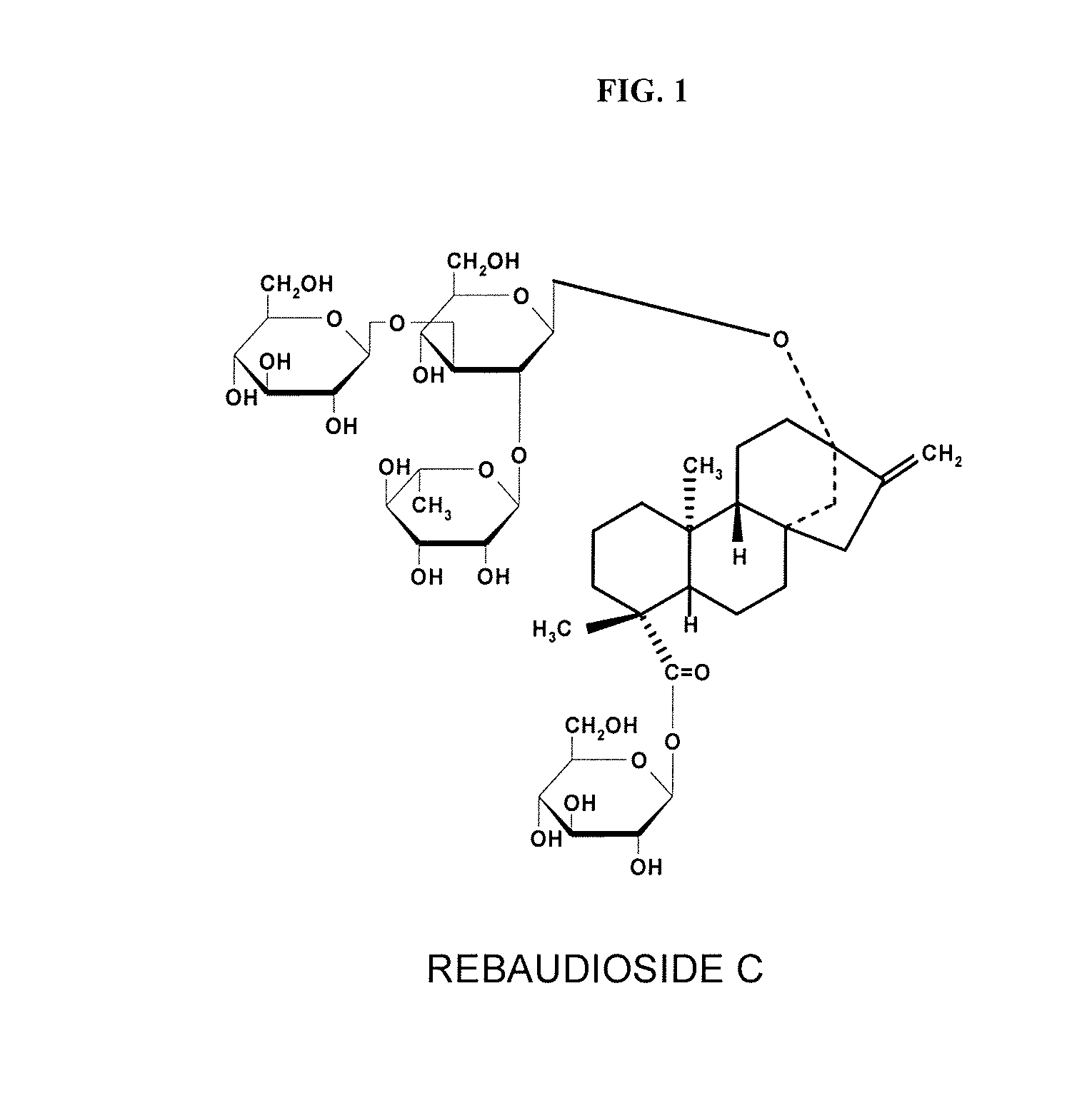Glucosyl rebaudioside c
a technology of rebaudioside and glucosylation, which is applied in the field of glucosylation, can solve the problems of difficult competition between sugar and non-sugar high-potency sweeteners, limiting their use in mainstream products, and affecting the flavor of the produ
- Summary
- Abstract
- Description
- Claims
- Application Information
AI Technical Summary
Benefits of technology
Problems solved by technology
Method used
Image
Examples
example 1
Preparation of Rebaudioside C
[0090]10 kg of stevia extract containing 10.1% (on dry basis) rebaudioside C was dissolved in 30 liters of 95% ethanol at 40° C. and cooled to 20° C. 5 g of highly purified rebaudioside A crystals were added as starter and the mixture was further incubated for 2 hours. The crystals of rebaudioside A (with 95.4% (on dry basis) rebaudioside A content) were separated and the filtrate was dried to obtain 4.9 kg powder with 20.1% rebaudioside C content.
[0091]The powder was dissolved in 15 liters of 90% methanol solution at 45° C. and cooled to 20° C. 2 g of highly purified Stevioside was added as a starter and the mixture was incubated for 48 hrs. Then the mixture was filtered to obtain 15 liters of filtrate and 4.8 kg of wet crystals. The filtrate was mixed with 15 liters of ethanol and seeded with 2 g of high purity rebaudiside A as a starter. Then it was incubated for 24 hours at 10° C. for crystallization. Precipitated crystals were separated and dried to...
example 2
Purification of Rebaudioside C
[0092]100 g of rebaudioside C prepared as per EXAMPLE 1 with 70.9% rebaudioside C content was dissolved in 200 mL of 90% methanol at 50° C. and cooled down to 10° C. 0.5 g of high purity rebaudioside A was added and the mixture was incubated at 10° C. for 24 hours. The mixture was filtered to separate the crystals. The crystals were dried to yield 19.1 g of Rebaudioside A with 97.3% purity. The filtrate was dried to yield 80.7 g of rebaudioside C with 87.6% purity.
example 3
Refining of Rebaudioside C by Re-Crystallization
[0093]100 g of rebaudioside C prepared as per EXAMPLE 2 was dissolved in 200 mL of 99% Methanol at 50° C. and cooled down to 5° C. 1 g of highly purified rebaudioside C was added as starter and the mixture was incubated at 5° C. for 24 hours. The crystals were separated by filtration and dried under vacuum at 55° C. to yield 80.3 g of rebaudioside C with 98.1% purity.
PUM
| Property | Measurement | Unit |
|---|---|---|
| Fraction | aaaaa | aaaaa |
| Fraction | aaaaa | aaaaa |
| Fraction | aaaaa | aaaaa |
Abstract
Description
Claims
Application Information
 Login to View More
Login to View More - R&D
- Intellectual Property
- Life Sciences
- Materials
- Tech Scout
- Unparalleled Data Quality
- Higher Quality Content
- 60% Fewer Hallucinations
Browse by: Latest US Patents, China's latest patents, Technical Efficacy Thesaurus, Application Domain, Technology Topic, Popular Technical Reports.
© 2025 PatSnap. All rights reserved.Legal|Privacy policy|Modern Slavery Act Transparency Statement|Sitemap|About US| Contact US: help@patsnap.com

